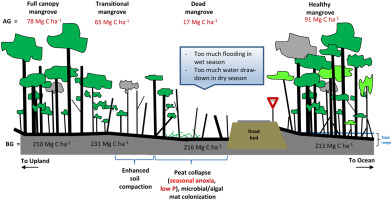Like the way our developmental goals and our race against each other is continuously paving the way for global warming and thus climate change.
In the same manner, Climate change is consistently at play, triggering intense storms, increased temperatures, frequent droughts and floods, glacial bursts and melting ice but there are several unseen-unfettered disasters brewing up.
A Ghost is pedaling its way into our alive forests, whatever is left of them. And it’s constantly snatching out lives without our notice.
It is well known that with increasing Global temperature, consequent Sea level rise on the planet and troubled Salinization, the remnant forests will fall under the perils of lifelessness.
But according to a new report published by Rutgers University and University of California on climate change, Ghost forests may haunt us everywhere along the coasts.
Ghost forests are landscapes which form when saltwater begins to seep-in the woodland areas covered by freshwater-dependent trees.
Saline water gradually suffocates trees as not every plant specie can survive saline sea water and once they die, left behind are the ghostly gray trunks of dead trees resembling toothpicks.
This exacerbates due to heavy rainfall, saltwater surges and further Inundation of forest areas.
Tidal creeks are comparatively small hydrologic areas that subsumes into larger estuaries.
They lies on the front lines of the interface between saltwater and freshwater ecosystems and are potentially the first areas to experience changes in sea level.
These changes can always be monitored to understand and act towards saving such fragile ecosystems.
Challenges and Doubts when monitoring changes in Transition areas:
1. Usability of Aerial surveillance to identify where freshwater forested wetlands have changed to salt marsh?
2. How can aerial photography and satellite imagery be used to record salinity movement upstream?
3. Have changes across different wetland ecosystems been same?
4. Look for any possible spatial resemblance in the physical geography of such areas.
Sea water does not alone kill trees but leaves soil unhealthy, infertile and turn forests uninhabitable for new growth making it impossible to replenish Nature and instill Life.
This report is definitely alarming as coastal forests are inhabited by many rare plants and wildlife, such as the threatened swamp pink plant.

The biodiversity created for the freshwater can’t seemingly survive on any other variant.
This, along with the invasive species capturing indigenous forest grounds, can lead to huge biodiversity loss and potentially wipe out several species from their habitats.
This can serve as a chain reaction for further forest land degradation.
With lesser number of evergreen trees, lesser carbon and other Green House Gases are absorbed by the cleansing trees and therefore lesser carbon is removed from the air.
Carbon sequestration supports our lifecycle, for sure it serves us a great deal by cleaning air through Nature’s own covert ways.
Wetlands and transition areas or Ecotone too, holds great biodiversity and serve as nature’s defences against its own risen disasters like Tsunami, cyclones etc.
But when humans interfere in such delicate ecosystems, disaster is in making.
Native trees are displaced, species find it difficult to survive, lives get lost and the ecosystems collapse, revealing the very cracks of Nature out in the open, developing Vulnerabilities and suddenly its impact on Human lives become invincible.
More troubling is the fact that it is not a regional or local phenomena.
If currently, this eerie view is available along mid-Atlantic, southern New England coast or coastal woodland forests ranging from Virginia through Massachusetts.
The US Department of Agriculture hired on the researchers to surmise “the current state of knowledge” concerning how Northeastern US coastal forests are responding to impacts from climate change.
Is there such case in India?
No such case of Ghost forest has been reported from India or any relevant study has not been undertaken yet to identify one.
But Nature conspires and it strengthen its own defences for balancing Earthly processes.
This may surely have spillover effect elsewhere.
Can we help our dying Forests?
To mitigate ghost forests following can be looked into:
1. Responsible land use planning:
coastal forests need more protection from development
proper planning, devoid of Constructions, hotels, recreational parks etc.
Lesser commercial plantation along coasts
Preventing over-exploitation of coastal resources.
Collaboration with landowners must be established to ensure recovery of land
Community reserves are to be conserved
An all-inclusive strategy for decentralisation in administration of such coastal transition areas needs to be stressed upon.
Salt tolerant plant species can be planted under proper guidance
Wetlands preservation may lead to emancipation from all such inherent problems.
Wetlands, marshes, swamps, corals: all act as natural barriers to such inundation.
If they are in place, no sea water rise may be able to seep in much and harm local trees.
Our planet has been treading a dangerous path. Our climate scientists are helping us in best possible ways to anticipate and mitigate against environmental challenges.
We are witnessing threats to our ecosystems and its consequences on our lives we could never have easily imagined.
Yet we dream of sustainability, we dream of peace for Nature, we dream of a new life for our souls and forests.
We dream and hope, that’s the required ingredient for achieving Sustainability and stopping our Planet to sweep into probably destined Comatose.




